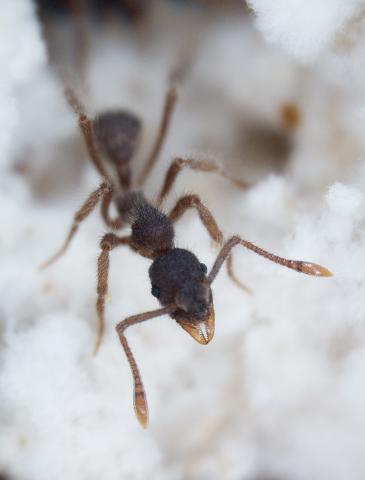
The fungus-growing ant, Apterostigma dentigerum, is the theme of this year’s Spring Research Festival. Courtesy of Michael Poulsen.
By Ashley DeVine, Staff Writer
For the first time, the Spring Research Festival (SRF), scheduled for May 8 and 9, will be sponsored by all of the agencies that are part of the National Interagency Confederation for Biological Research (NICBR).
“That means that all of our NICBR partners at Fort Detrick will be working together to organize and support the festival, which focuses on the most recent collaborative biological research from our respective scientists, technicians, fellows, and students,” said Kristin Komschlies, Ph.D., NICBR Fort Detrick Interagency Coordinating Committee (FDICC) representative for NCI.
NICBR comprises the following agencies, which are co-located at Fort Detrick: the National Biodefense Analysis and Countermeasures Center, Department of Homeland Security; the National Cancer Institute; the Agricultural Research Service, United States Department of Agriculture; the Centers for Disease Control and Prevention; the National Institute of Allergy and Infectious Diseases; the Naval Medical Research Center; the U.S. Army Medical Research and Materiel Command; and the U.S. Food and Drug Administration.
“The annual Spring Research Festival provides a venue for our scientists to present their research findings, network with other NICBR scientists across research disciplines, and establish new collaborative relationships,” said Doug Luster, who leads the Agricultural Research Service’s Foreign Disease-Weed Science Research Unit.
Fungus-Growing Ant Chosen as Theme
The theme of the 17th annual SRF is Apterostigma dentigerum, a fungus-growing ant that is native to Central and South America. The ants have mutualistic, or mutually beneficial, interactions with fungus, which they use for food, and actinobacteria, which produce selective antibiotics to protect the fungus from parasites.1
According to David Newman, D. Phil., chief, Natural Products Branch of the Developmental Therapeutics Program, “It is, in fact, quite common for antifungal agents to have reasonable antitumor activity when tested, due to the very close biochemical similarity of fungi to man in a genetic sense.”
Festival Week Kicks Off May 6
The NICBR postdoctoral/ postbaccalaureate symposium entitled “Host Response to Disease,” will kick off festival week on May 6, beginning at 8:30 a.m. in the Building 549 auditorium.
On May 7, some of the collaborative research taking place through NICBR will be presented in a forum at the NICBR Research Collaborations Symposium in the Building 549 auditorium.
Poster presentations will take place on May 8 and 9 from 10 a.m. to 2:30 p.m. Registration for SRF exhibitors, speakers, and poster presenters is open until April 19. The festival location is the back parking lot of Building 1507 (Odom Fitness Center).
The SRF will also include a health and safety exposition, educational information, safety and scientific displays, and commercial exhibits of the latest scientific equipment and technologies.
For more information, visit the SRF website: http://ncifrederick.cancer.gov/Events/Srf, or contact Julie Hartman, SRF chair, at srfnci-frederick@mail.nih.gov or 301-846-7338.
Source:
1Oh, D-C., Poulsen, M., Currie, C.R., and Clardy, J. (2009). Dentigerumycin: a bacterial mediator of an ant-fungus symbiosis. Nature Chemical Biology 5(6): 391–393.

